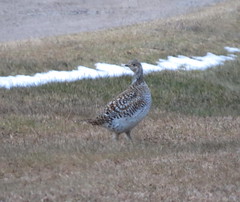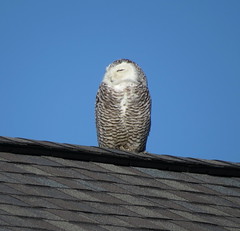“In Search of Red-necked Grebes”
This years great Red-necked Grebe invasion has taken the state by storm, and now it’s Jon’s and my chance to track down these visitors from the north. As you can see by the range map below that I downloaded from the web site, “All About Birds”, we may get one a year during the winter. Last winter we had one that stayed at Hidden Valley Lake for a long time and was included in my January 100 Species Challenge

They do winter over down into the United States, but it’s normally along both coasts. So what are they doing down here and in such great numbers? Well I’m sure thee is a logical ornithological reason for such an influx, but I’m pretty confident that this exceptionally cold winter has something to do with it. So whatever the reason we were out in the field and meeting up Grand Valley as our first stop.
With his Grandmothers birthday celebration in the early afternoon, our time was limited as we drove through the gate into Grand Valley. Still partially frozen over with only small pockets of open water, we quickly scanned the lake only to find 10 Common Mergansers that quickly took off and some Canadian Geese.
On to the back lake which held a bounty of some good waterfowl, including 3 Red-necked Grebes.
 Difficult to see at first but there are loads of tiny black dots on the lake mostly on the other side of the small island.
Difficult to see at first but there are loads of tiny black dots on the lake mostly on the other side of the small island.
 After watching them fish for a while these 2 decided to take a nap while the thrid continued to feed.
After watching them fish for a while these 2 decided to take a nap while the thrid continued to feed.
 I had to shoot this one quick because the Grebe had it eaten really quick.
I had to shoot this one quick because the Grebe had it eaten really quick.

The difficulty with digiscoping is trying to focus on a moving bird and coming away with a clear picture. And if the sun is behind you then the view through the camera monitor glares back at you. So most of the pictures are out of focus.
So here we are at our first stop and we have 3 RNGR already. Is this what we are to expect today? So our next stop where one was reported was Armleder Park, which is just upstream from the Ohio River with the Little Miami River running along it’s eastern border. And bordering along it’s southern edge is Duck Creek. It’s here where Duck Creek runs into the Little Miami is where we need to set up. After twice falling on the slippery slopes we made it to our destination. Footing was difficult with all the mud, however when we looked downstream we found 3 more RNGR. This is getting crazy. Like I told Jon, “you can’t swing a cat without hitting one”.
Totally satisfied with now sighting 6 individuals we trudged through the mud back to our respective cars. So where to next? Well being close to the Ohio River this area is known for all it’s marinas which are tucked back off the Ohio River through man-made channels. And one of the largest, 4 Seasons Marina, has this driving range next to it. But it’s not your conventional kind of driving range. This one has a lake that you hit the ball into, and they have these floating markers that show the distance. Well it’s on this driving range lake where we found yet another RNGR. This time a male showing it’s breeding plumage.

 On these last 2 photos you can really tell how they got their name.
On these last 2 photos you can really tell how they got their name.
So after we left this marina we went just 2 marina down from us called Harbor Town Marina. We walked down to the channel and found another RNGR. This one another solo bird and it was actively feeding. Do to the distance and the position of the sun I took no photo.
So after finding 8 different birds we made our way to California Golf Course. Located on the golf course is a very large reservoir that is used by the Cincinnati Water Works. And it’s here that we find the last RNGR for the day. Another lone male bird amongst all the other water fowl that speckled the lake.
Having thought we might have missed out on this last invasion of this magnificent bird, we came away with 9 different individuals. Now this may sound like a lot, but remember they’re all over the place down here, either on our large lakes of rivers. How long will this go on? No ones guess. Just like the Snowy Owls, here one day, then gone the next.
So what’s in store for us in the Ohio valley. Well with spring knocking on the door, hopefully warblers. And you know how much we love warblers here at A Birders Notebook.
Notable birds for the day include:
- Red-winged Black Birds
- American Crow
- American Robin
- Northern Cardinal
- Carolina Chickadee
- Pileated Woodpecker
- Downy Woodpecker
- Red-bellied Woodpecker
- Song Sparrow
- White-throated Sparrow
- White-crowned Sparrow
- Field Sparrow
- Red-shouldered Hawk
- Red-tailed Hawk
- Mourning Dove
- Common Grackle
- Tree Swallow
- Canada Goose
- Northern Shoveler
- Common Merganser
- Red-breasted Merganser
- Hooded Merganser
- Mallard
- Wood Duck
- Common Goldeneye
- Pied-billed Grebe
- Red-necked Grebe
- Turkey Vulture
- Black Vulture
- Eastern Bluebird
- Killdeer
- Bufflehead
- Gadwall
- American Wigeon
- Ring-neck Duck
- American Coot
- Redhead
- Northern Mockingbird
- Lesser Scaup
- Greater Scaup
- Blue Jay
- Ring-billed Gull
- Herring Gull
- Belted Kingfisher



























